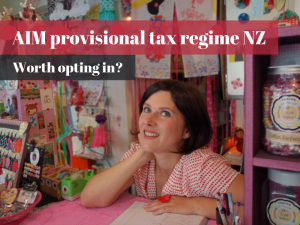
 What is AIM provisional tax?
What is AIM provisional tax?
The AIM provisional tax regime was introduced on April 1st 2018 in an attempt to simplify provisional tax for small businesses in New Zealand.
Since its introduction, the new tax regime has been successful for all sorts of NZ businesses.
Sole traders – new and existing businesses, new limited companies growing limited companies and limited companies going through an investment phase have all benefited from the new system.
We’ve worked closely with companies and sole traders at each of these stages throughout the past year and the feedback has been universally positive.
Under the new regime, you pay provisional tax in line with the profit made throughout the year.
Please note that you DO still need to lodge a tax return at the end of the year. The AIM provisional tax regime does NOT replace that.
However, your annual tax return will take into account the AIM provisional tax you have paid throughout the year, just like normal provisional tax regime does and, if applicable, return any overpaid tax when your return is lodged.
If your business has a two-month period where you make a profit, you will pay provisional tax for that two-month period, based on your applicable tax rate.
However, if you make a loss over a two-month period, you will not pay any provisional tax AND you may be eligible for a refund.
The profit calculation is made on a year-to-date basis. So, if you have a period where the two months made the current year-to-date position worse than the year-to-date position two months ago, you’re eligible for a provisional tax refund.
You can choose to claim this refund at the time or roll it over to the next period. That’s up to you.
The most common benefits our clients have experienced with the AIM provisional tax system are:
These benefits have been experienced consistently by our clients over the course of the past 12 months or so.
To be eligible to opt in to use AIM, you need to:
The point about having to use an accountant has been loudly touted as a reason not to opt in for the AIM provisional tax regime.
It’s been suggested that any benefits you receive will be offset by the additional costs incurred by having to hire an accountant in do the work.
Yes, there will be a small increase in accounting fees but the value you will receive by opting in far outweighs these extra costs.
In my opinion, your accountant should be reviewing your files regularly anyway, so that you have the most accurate and up-to-date information available with which to make business decisions.
We do this as a matter of course and, if your accountant is not providing this level of service, then it may be time for a re-think.
The Inland Revenue has recently changed its policy to allow businesses to opt in to the AIM provisional tax regime at any stage during the financial year.
This could be of great benefit to many small business owners considering whether to make the switch.
Note that, should you opt in, you’re required to follow the regime for the remainder of the financial year at least.
That said, there are better times than others to make the switch.
If you’d like to discuss whether now is the right time for your business to move to the AIM provisional tax regime, book a meeting with us here.